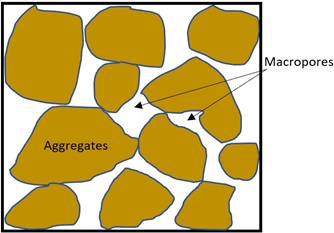|
Humin
Humins are carbon-based macromolecular substances, that can be found in soil chemistry or as a by-product from saccharide-based biorefinery processes. Humins in soil chemistry Soil consists of both mineral (inorganic) and organic components. The organic components can be subdivided into fractions that are soluble, largely humic acids, and insoluble, the humins. Humins make up about 50% of the organic matter in soil. Due to their very complex molecular structure, humic substances, including humin, do not correspond to pure substances but consist of a mixture of many compounds that remain very difficult to characterize even using modern analytical techniques. Humins from biomass sources Humins also produced during the dehydration of sugars, as occurs during the conversion of lignocellulosic biomass to smaller, higher value organic compounds such as 5-hydroxymethylfurfural (HMF). These humins can be in the form of either viscous liquids or solids depending on the process conditi ... [...More Info...] [...Related Items...] OR: [Wikipedia] [Google] [Baidu] |
Humic Acid
Humic substances (HS) are colored relatively recalcitrant organic compounds naturally formed during long-term decomposition and transformation of biomass residues. The color of humic substances varies from bright yellow to light or dark brown leading to black. The term comes from humus, which in turn comes from the Latin word '' humus'', meaning "soil, earth". Humic substances represent the major part of organic matter in soil, peat, coal, and sediments, and are important components of dissolved natural organic matter (NOM) in lakes (especially dystrophic lakes), rivers, and sea water. Humic substances account for 50 – 90% of cation exchange capacity in soils. "Humic substances" is an umbrella term covering humic acid, fulvic acid and humin, which differ in solubility. By definition, humic acid (HA) is soluble in water at neutral and alkaline pH, but insoluble at acidic pH < 2. Fulvic acid (FA) is soluble in water at any pH. Humin is not soluble in water at any pH. This def ... [...More Info...] [...Related Items...] OR: [Wikipedia] [Google] [Baidu] |
Humus
In classical soil science, humus is the dark organic matter in soil that is formed by the decomposition of plant and animal matter. It is a kind of soil organic matter. It is rich in nutrients and retains moisture in the soil. Humus is the Latin word for "earth" or "ground". In agriculture, "humus" sometimes also is used to describe mature or natural compost extracted from a woodland or other spontaneous source for use as a soil conditioner. It is also used to describe a topsoil horizon that contains organic matter (''humus type'', ''humus form'', or ''humus profile''). Humus has many nutrients that improve the health of soil, nitrogen being the most important. The ratio of carbon to nitrogen ( C:N) of humus commonly ranges between 8:1 and 15:1 with the median being about 12:1. It also significantly improves (decreases) the bulk density of soil. Humus is amorphous and lacks the cellular structure characteristic of organisms. The solid residue of sewage sludge treatment, w ... [...More Info...] [...Related Items...] OR: [Wikipedia] [Google] [Baidu] |
Soil Chemistry
Soil chemistry is the study of the Chemistry, chemical characteristics of soil. Soil chemistry is affected by mineral composition, organic matter and Environment (biophysical), environmental factors. In the early 1870s a consulting chemist to the Royal Agricultural Society of England, Royal Agricultural Society in England, named J. Thomas Way, performed many experiments on how soils exchange ions, and is considered the father of soil chemistry. Other scientists who contributed to this branch of ecology include Edmund Ruffin, and Linus Pauling. History Until the late 1960s, soil chemistry focused primarily on chemical reactions in the soil that contribute to pedogenesis or that affect plant growth. Since then, concerns have grown about environmental pollution, organic and inorganic soil contamination and potential ecological health and environmental health risks. Consequently, the emphasis in soil chemistry has shifted from pedology and agricultural soil science to an emphasis on e ... [...More Info...] [...Related Items...] OR: [Wikipedia] [Google] [Baidu] |
Biomass
Biomass is a term used in several contexts: in the context of ecology it means living organisms, and in the context of bioenergy it means matter from recently living (but now dead) organisms. In the latter context, there are variations in how biomass is defined, e.g., only from plants, from plants and algae, from plants and animals. The vast majority of biomass used for bioenergy does come from plants and fecal matter. Bioenergy is a type of renewable energy that the bioenergy industry claims has the potential to assist with climate change mitigation. Uses in different contexts Ecology * Biomass (ecology), the mass of living biological organisms in a given area or ecosystem at a given time. This can be the biomass of particular species or the biomass of a particular community or habitat. Energy * Biomass (energy), biomass used for energy production or in other words: biological mass used as a renewable energy source (usually produced through agriculture, forestry or ... [...More Info...] [...Related Items...] OR: [Wikipedia] [Google] [Baidu] |
Soil Organic Matter
Soil organic matter (SOM) is the organic matter component of soil, consisting of plant and animal detritus at various stages of decomposition, cells and tissues of soil microbes, and substances that soil microbes synthesize. SOM provides numerous benefits to soil's physical and chemical properties and its capacity to provide regulatory ecosystem services. SOM is especially critical for soil functions and quality. The benefits of SOM result from several complex, interactive, edaphic factors; a non-exhaustive list of these benefits to soil function includes improvement of soil structure, aggregation, water retention, soil biodiversity, absorption and retention of pollutants, buffering capacity, and the cycling and storage of plant nutrients. SOM increases soil fertility by providing cation exchange sites and being a reserve of plant nutrients, especially nitrogen (N), phosphorus (P), and sulfur (S), along with micronutrients, which the mineralization of SOM slowly rele ... [...More Info...] [...Related Items...] OR: [Wikipedia] [Google] [Baidu] |
Organic Matter
Organic matter, organic material or natural organic matter is the large source of carbon-based compounds found within natural and engineered, terrestrial, and aquatic environments. It is matter composed of organic compounds that have come from the feces and remains of organisms such as plants and animals. Organic molecules can also be made by chemical reactions that do not involve life. Basic structures are created from cellulose, tannin, cutin, and lignin, along with other various proteins, lipids, and carbohydrates. Organic matter is very important in the movement of nutrients in the environment and plays a role in water retention on the surface of the planet. Formation Living organisms are composed of organic compounds. In life, they secrete or excrete organic material into their environment, shed body parts such as leaves and roots and after organisms die, their bodies are broken down by bacterial and fungal action. Larger molecules of organic matter can be formed from t ... [...More Info...] [...Related Items...] OR: [Wikipedia] [Google] [Baidu] |
Proof Of Concept
A proof of concept (POC or PoC), also known as proof of principle, is an inchoate realization of a certain idea or method in order to demonstrate its feasibility or viability. A proof of concept is usually small and may or may not be complete, but aims to demonstrate in principle that the concept has practical potential without needing to fully develop it. A proof of value (PoV) is sometimes used along proof of concept, and differs by focusing more on demonstrating the potential customer use case and value, and is usually less in-depth than a proof of concept. Usage history The term has been in use since 1967. In a 1969 hearing of the Committee on Science and Astronautics, Subcommittee on Advanced Research and Technology, ''proof of concept'' was defined as following: One definition of the term "proof of concept" was by Bruce Carsten in the context of a "proof-of-concept prototype" in his magazine column "Carsten's Corner" (1989): The column also provided definitions fo ... [...More Info...] [...Related Items...] OR: [Wikipedia] [Google] [Baidu] |
Catalytic
Catalysis () is the increase in reaction rate, rate of a chemical reaction due to an added substance known as a catalyst (). Catalysts are not consumed by the reaction and remain unchanged after it. If the reaction is rapid and the catalyst recycles quickly, very small amounts of catalyst often suffice; mixing, surface area, and temperature are important factors in reaction rate. Catalysts generally react with one or more reactants to form reaction intermediate, intermediates that subsequently give the final reaction product, in the process of regenerating the catalyst. The rate increase occurs because the catalyst allows the reaction to occur by an alternative mechanism which may be much faster than the noncatalyzed mechanism. However the noncatalyzed mechanism does remain possible, so that the total rate (catalyzed plus noncatalyzed) can only increase in the presence of the catalyst and never decrease. Catalysis may be classified as either homogeneous catalysis, homogeneou ... [...More Info...] [...Related Items...] OR: [Wikipedia] [Google] [Baidu] |
Macropore
In soil, macropores are defined as cavities that are larger than 75 μm. Functionally, pores of this size host preferential soil solution flow and rapid transport of solutes and colloids. Macropores increase the hydraulic conductivity of soil, allowing water to infiltrate and drain quickly, and shallow groundwater to move relatively rapidly via lateral flow. In soil, macropores are created by plant roots, soil cracks, soil fauna, and by aggregation of soil particles into peds. Macropores can also be found in soil between larger individual mineral particles such as sand or gravel. Macropores may be defined differently in other contexts. Within the context of porous solids (i.e., not porous aggregations such as soil), colloid and surface chemists define macropores as cavities that are larger than 50 nm. Formation of soil macropores Primary particles (sand, silt and clay) in soil are bound together by various agents and under different processes to form soil aggrega ... [...More Info...] [...Related Items...] OR: [Wikipedia] [Google] [Baidu] |
Hazardous Material
Dangerous goods are substances that are a risk to health, safety, property or the Natural environment, environment during transport. Certain dangerous goods that pose risks even when not being transported are known as hazardous materials (syllabic abbreviation, syllabically abbreviated as HAZMAT or hazmat). An example of dangerous goods is hazardous waste which is waste that threatens public health or the environment. Hazardous materials are often subject to Regulation of chemicals, chemical regulations. Hazmat teams are personnel specially trained to handle dangerous goods, which include materials that are radioactive, flammable, explosive, corrosive, oxidizer, oxidizing, asphyxiant gas, asphyxiating, biohazardous, Toxicity, toxic, poisonous, pathogenic, or allergenic. Also included are physical conditions such as compressed gases and liquids or hot materials, including all goods containing such materials or chemicals, or may have other characteristics that render them hazardo ... [...More Info...] [...Related Items...] OR: [Wikipedia] [Google] [Baidu] |
Nucleophilic Addition
In organic chemistry, a nucleophilic addition (AN) reaction is an addition reaction where a chemical compound with an electrophilic double or triple bond reacts with a nucleophile, such that the double or triple bond is broken. Nucleophilic additions differ from electrophilic additions in that the former reactions involve the group to which atoms are added accepting electron pairs, whereas the latter reactions involve the group donating electron pairs. Addition to carbon–heteroatom double bonds Nucleophilic addition reactions of nucleophiles with electrophilic double or triple bond (π bonds) create a new carbon center with two additional single, or σ, bonds.March Jerry; (1985). Advanced Organic Chemistry reactions, mechanisms and structure (3rd ed.). New York: John Wiley & Sons, inc. Addition of a nucleophile to carbon–heteroatom double or triple bonds such as >C=O or -C≡N show great variety. These types of bonds are polar (have a large difference in electronegativit ... [...More Info...] [...Related Items...] OR: [Wikipedia] [Google] [Baidu] |





